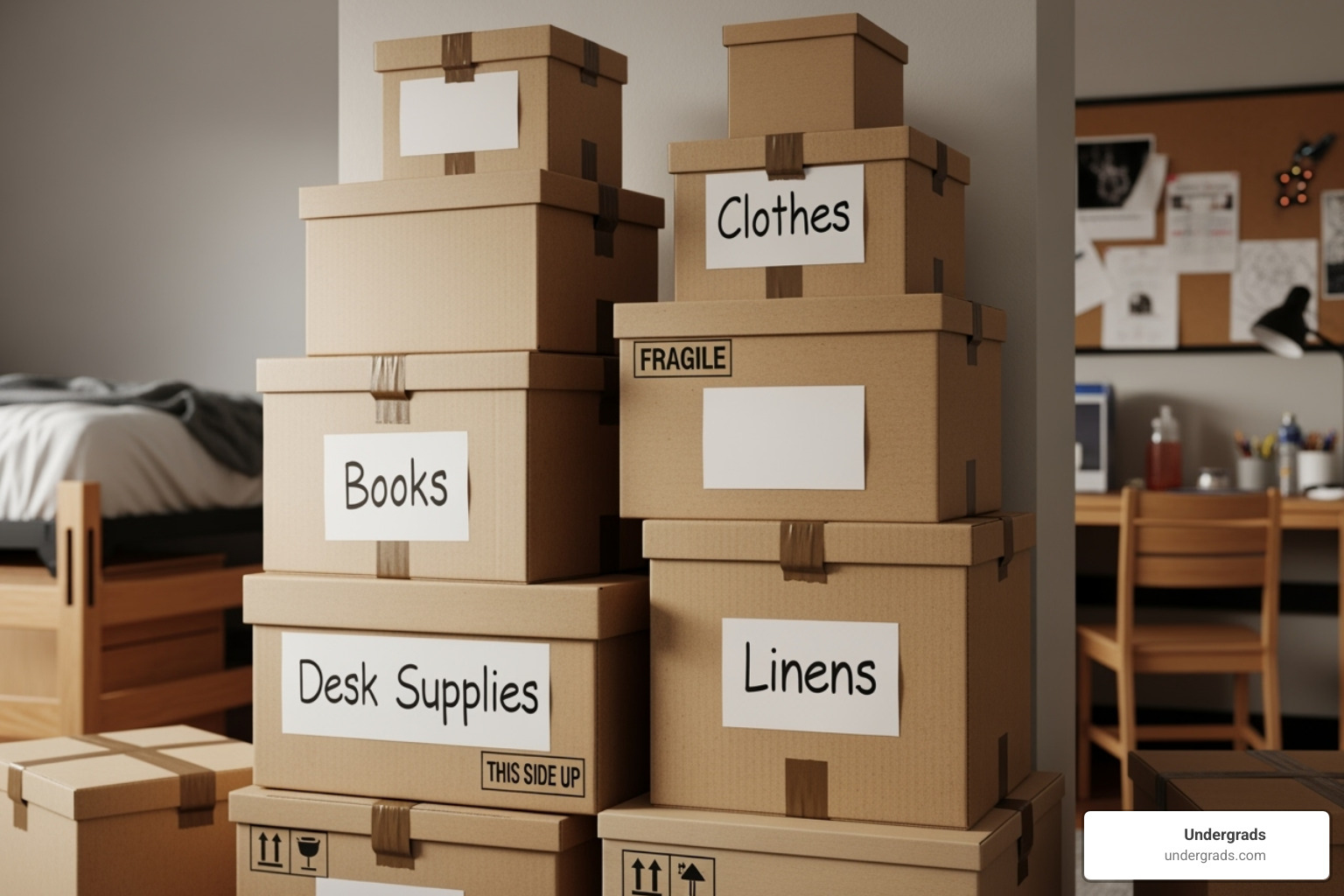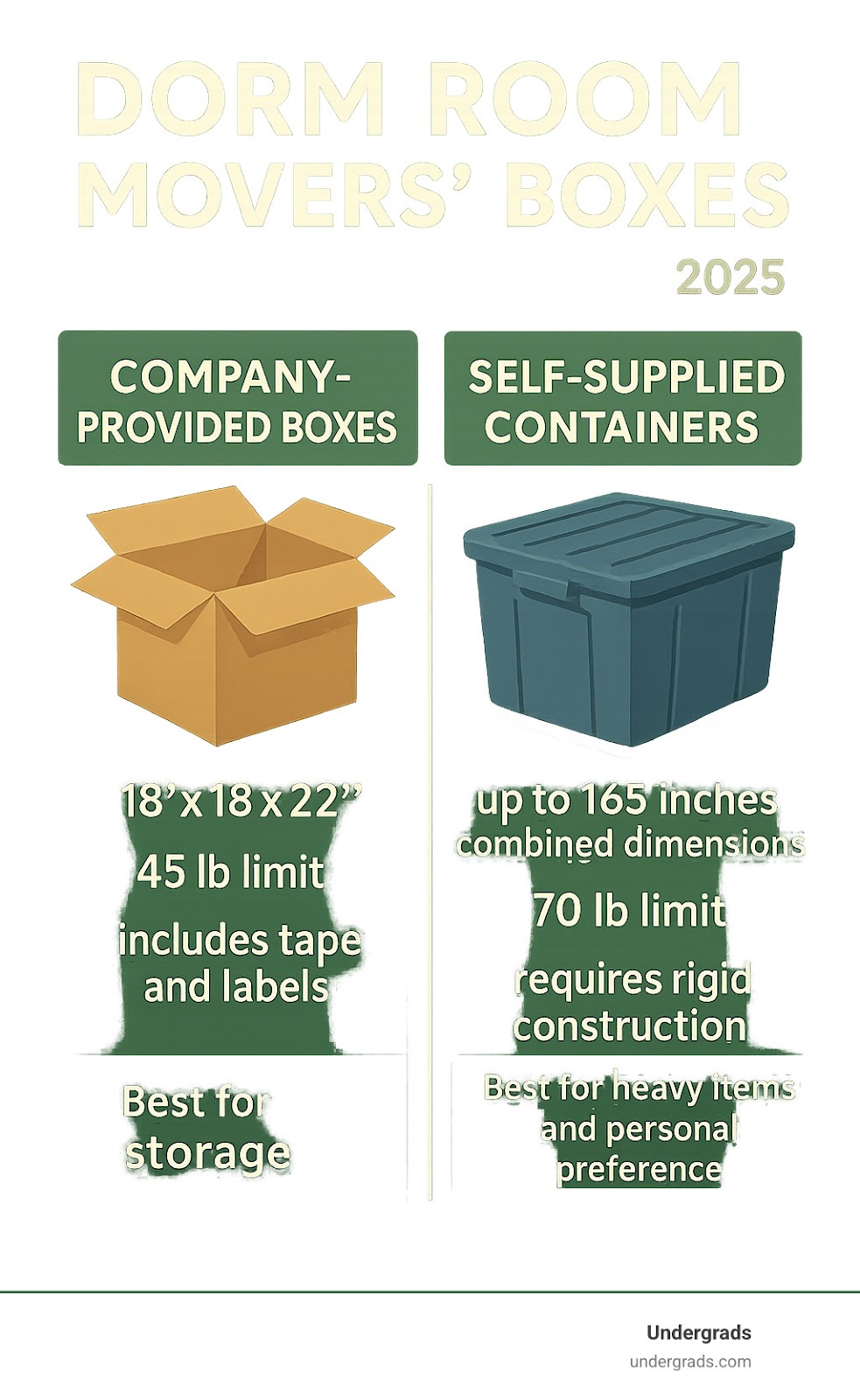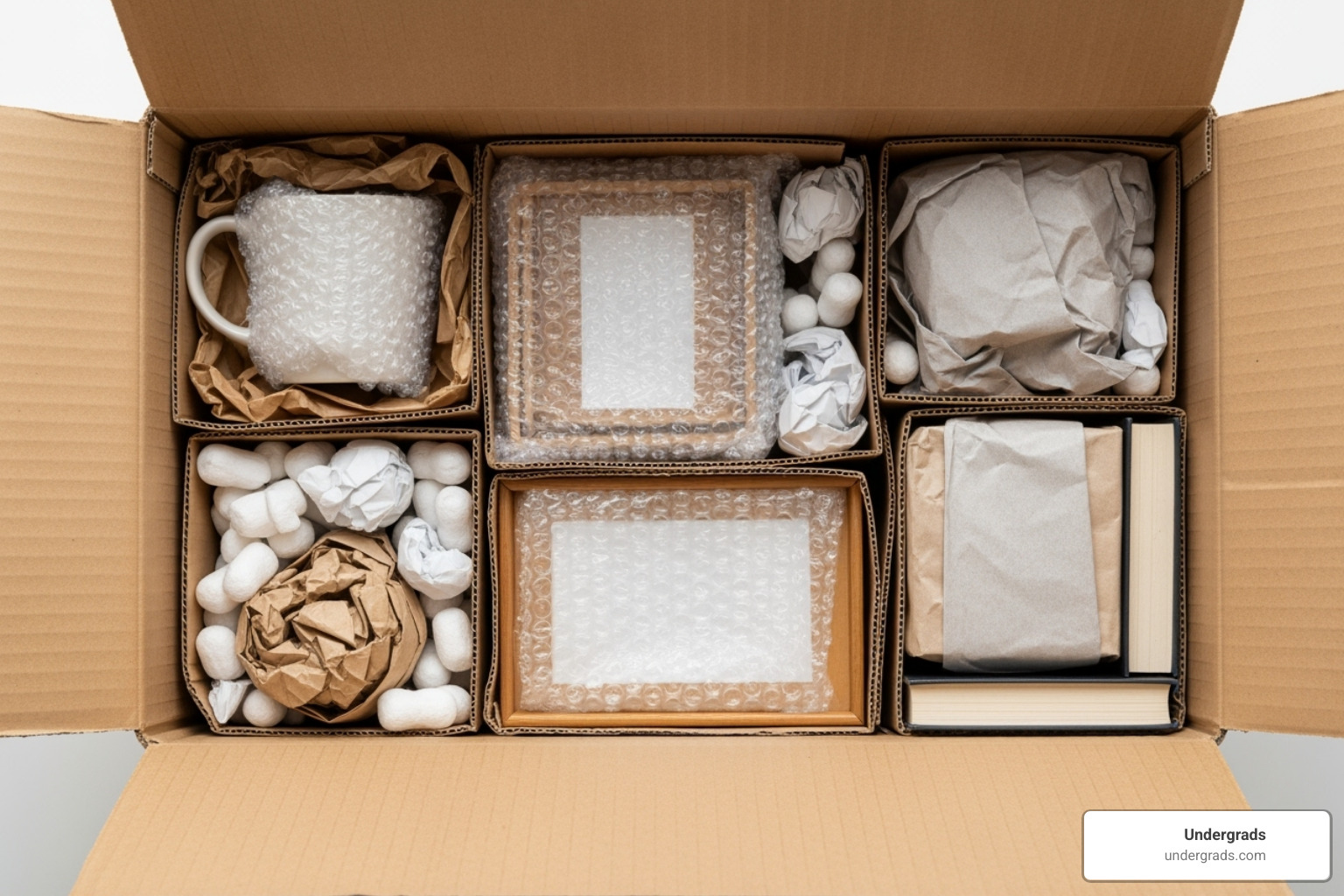
Boxes for moving out of a dorm come in two main types: company-provided kits and self-supplied containers. Here’s what you need to know:
Company-Provided Boxes:
- Dimensions: 18″x18″x22″ (4.125 cubic feet)
- Weight limit: 45 lbs
- Includes: 5 boxes, tape, labels
- Best for: Storage and light shipping
Self-Supplied Containers:
- Max size: 165 inches (length + girth)
- Weight limit: 70 lbs (fees apply over 40 lbs)
- Options: Plastic bins, trunks, rigid boxes
- Best for: Heavier items and personal preference
Moving out of your dorm can be chaotic, but the right boxes make all the difference between a smooth move and a stressful disaster. As one college blogger put it: “It was giving the Hulk, minus the green skin and irrational anger.”
Most student moving services provide standard box kits, but you’re not stuck with just those options. Whether you choose their boxes or bring your own, understanding the rules around weight, dimensions, and packing will save you from surprise fees and damaged belongings.
I’m Thomas Mumford with Undergrads. I’ve seen how the wrong moving boxes can turn move-out day into a nightmare. This guide will help you choose the right containers and pack them properly for a stress-free transition.

What’s Inside? A Look at Standard Dorm Mover Box Kits
When you sign up with a professional dorm moving service, most provide a complete box kit. It arrives weeks before your move, so you have everything you need without a last-minute scramble for supplies.
These boxes are designed for the job. Moving companies create their dorm moving boxes specifically for the challenges students face—your stuff needs to survive moves between dorms, storage, and potentially cross-country shipping.
Think of it as a moving starter pack that takes the guesswork out of packing. Instead of wondering if you have enough tape or the right size boxes, everything arrives in one convenient package.
Box Specifications and Capacity
The standard dorm moving boxes that most services provide measure 18″ x 18″ x 22″, which gives you 4.125 cubic feet of packing space. For perspective, one box can typically hold an entire bedding set, including pillows and a comforter.
These boxes aren’t just big—they’re tough. They’re made from 44 ECT single wall corrugated cardboard, meaning they can handle serious weight without collapsing. The 44 lb crush test rating ensures your boxes won’t buckle when stacked, and they’re designed to hold up to 45 pounds safely.
So what fits in these containers? Your bedding takes up about one box, while textbooks can fill another (but be mindful of the weight limit, as textbooks are heavy). Clothing packs efficiently when folded properly, and you can fit everything from jeans to winter coats in a single box.
The key is thinking strategically about weight distribution. Books and electronics go in one box, while lighter items like clothes and bedding can max out the space in another.
What Comes with the Kit
A complete box kit is like a care package for moving. You’ll receive five large boxes that arrive flat-packed, plus a roll of packing tape strong enough to keep your boxes sealed.
The pre-printed labels are where things get really organized. They include spaces for your name, order number, and whether each box is headed for storage or direct shipping. Some services even include barcode tracking so you can follow your belongings.
Many kits also include extras like zip ties and label pouches for items that don’t fit in boxes, like a mini-fridge or desk fan. This ensures nothing gets lost in the shuffle.
This all-in-one approach means you can focus on packing instead of hunting for supplies. If you need more, check out our guide on the essential moving supplies list for a labor-only move.

Using Your Own Boxes and Bins: What You Need to Know
You don’t have to use the standard company kit. Many dorm moving services allow you to use your own containers, like plastic totes, sturdy suitcases, or vintage trunks.
Using your own moving boxes and containers can be a smart move. You might save money or have containers that work better for your items. An oversized suitcase might be perfect for winter coats, while plastic bins are ideal for items you’ll need to access quickly.
However, there are strict rules for self-supplied containers. Ignoring them can lead to damaged items, denied insurance claims, or surprise fees.
Requirements for Self-Supplied Containers
When you go the DIY route with containers, moving services have requirements to protect your belongings and keep the operation running smoothly.
First, rigid construction is non-negotiable. Your container must be sturdy enough to handle stacking and moving. For cardboard boxes, look for ones with all flaps intact and preferably double-walled construction with an Edge Crush Test (ECT) rating of 42 or higher.
Size matters too. Self-supplied containers can’t exceed 165 inches in combined length and girth. To calculate this, take the longest side (length), then add twice the width plus twice the height. For a 24″ x 18″ x 16″ box, that’s 24 + (2×18) + (2×16) = 92 inches. Always round up to be safe.
The weight limit is where things get interesting. While you can pack up to 70 pounds in your own container, anything over 40 pounds will likely trigger overage fees. Those fees can add up quickly, so avoid cramming all your textbooks into one box. Company-provided boxes have a 45-pound limit before fees kick in.
If you’re wondering what items might cause problems, check our guide on What Not To Pack for helpful insights.
What to Avoid Packing In
A crucial tip: do not use trash bags or other plastic bags for packing. While convenient for clothes, it’s a mistake that can ruin your move.
Plastic bags rip easily under the weight of clothes or when shifted during transport. Your belongings could get scattered, dirty, or lost.
Even worse, items in plastic bags face a much higher risk of damage from moisture, dust, or impacts. Your clothes could end up dirty or wet.
Crucially, insurance claims for items in plastic bags are almost always denied. Moving services explicitly exclude coverage for improperly packed items. You’re gambling with your belongings and giving up any protection if something goes wrong.
Stick with approved options: sturdy cardboard boxes, plastic totes with lids, hard-shell suitcases, trunks, footlockers, and proper garment bags. These containers protect your stuff and keep you covered under the service’s valuation protection.
Pack Like a Pro: Securing Your Belongings for Transit and Storage
Imagine unpacking after summer break to find your favorite mug shattered or your laptop screen cracked. Proper packing prevents this.
Packing isn’t just about cramming everything into a box. It’s about creating a protective cocoon for your belongings that can survive the journey from your dorm to storage and back. How you pack makes all the difference between finding your stuff intact or dealing with a mess.
With the right techniques, you can pack like a pro. Most dorm moving services offer valuation protection (usually around $150 per box), but that coverage only applies if you’ve packed everything properly according to their guidelines.
Best Practices for Packing
Think of packing as creating a stable environment inside each box where nothing can shift or crash into other items during transit.
Weight distribution is your first line of defense. Spread heavy items throughout the box and balance them with lighter stuff. For company-provided moving boxes, stick to the 45-pound limit. If using your own containers, remember you’ll face extra fees for anything over 40 pounds, even though they can hold up to 70 pounds.
Cushioning material is essential. Fill every empty space with packing paper, bubble wrap, or even soft items like towels and t-shirts. Just don’t use heavy fabrics that might push your box over the weight limit.
Wrapping items separately is insurance against disaster. A ceramic mug needs its own protective layer. When items can’t scratch or break each other, everyone wins.
For taping methods, use the H-taping technique. Apply three strips of strong packing tape across the bottom and top seams, extending a few inches down the sides. This reinforces the box’s most vulnerable points. The expert packing guidelines from UPS provide detailed instructions.
For more advice, check our guide on How To Pack For A Labor Only Move.
Protecting Valuables and Electronics
Your gaming console, laptop, and other expensive items deserve special treatment. They represent both sentimental and monetary value.
The golden rule for electronics protection is to use original packaging whenever possible. Those custom-fit foam inserts were engineered to protect your TV, computer, or gaming console during shipping. If you tossed those boxes, invest in specialized electronics boxes with plenty of cushioning.
It’s important to know that many student moving services require original packaging for electronics to be covered by their valuation protection. Pack your PlayStation in a random box with towels, and any damage claim might be denied. It’s about both physical protection and ensuring coverage.
If original packaging isn’t an option, wrap electronics in anti-static bubble wrap and nestle them securely in rigid boxes with cushioning on all sides. They should be snug and unable to move.

The Definitive Guide to Dorm Room Moving Boxes, Labels, and Fees
Understanding labeling and weight limits is key to avoiding unexpected fees. Many students get hit with surprise charges because they overlook these rules. Once you understand how moving boxes need to be labeled and what triggers extra fees, avoiding these pitfalls is easy. Let’s break down what you need to know to keep your move on track and on budget.
How to Label Your Dorm Room Moving Boxes Correctly
Proper labeling is your box’s passport; without it, your items can get lost. Each label is a critical communication tool between you, the moving service, and the final destination.
- Your full name and order number should be on every box. This is your primary identifier.
- The storage versus shipping designation is equally crucial. Mark each box clearly with its intended destination.
- The complete destination address needs to be clearly visible on boxes being shipped. Double-check the address for accuracy.
Pro tip: Place a duplicate label inside each box. If the external label gets damaged or torn off, this internal backup can ensure your box reaches its destination.
Avoiding Extra Fees: Weight and Size Limits
Weight limits are hard rules that impact your wallet. The 45-pound limit for standard moving boxes exists for a reason, and exceeding it triggers overage fees that can add up.
For self-supplied containers, the math is trickier. While they can hold up to 70 pounds, overage fees often kick in at 40 pounds. You might pack a box thinking you’re within limits, only to find charges on your final bill.
The size calculation for self-supplied boxes is length plus two times the width plus two times the height, with a maximum of 165 inches total. Always round measurements up to the nearest inch, as moving companies will do the same.
Before pickup day, use a bathroom scale to weigh each box. If one is overweight, redistribute items. Paying for an extra box is almost always cheaper than paying overage fees. This aligns with the cost-conscious approach in our guide on Affordable Ways For College Students To Move.

More Than Just Cardboard: Integrating Boxes with Labor-Only Moving
Packing boxes is just one piece of the puzzle. While specialized student moving services handle supplies and transport, you still need someone for the heavy lifting. That’s where labor-only moving services like Undergrads come in. We bridge the gap between your packed boxes and getting them loaded onto a truck or into your new space.
Moving day is stressful enough without hauling heavy boxes down several flights of stairs. Our vetted student movers handle the physical demands while you focus on logistics.

How Box Kits Fit into the Moving Process
Here’s how your moving boxes flow through the entire process, and where professional help makes a difference.
- Registration: You sign up with a dorm moving service, and they ship your supply kit.
- Packing: You organize and pack everything according to the guidelines.
- Pickup: On pickup day, Undergrads can step in. While the dorm moving service handles long-haul transport, our movers excel at getting your packed moving boxes safely out of your dorm and loaded.
- Storage/Shipping: Your boxes head to a storage facility or your new destination.
- Delivery: When fall arrives, your boxes return. Our team can unload everything and place your moving boxes where you need them.
This integrated approach ensures a smooth process. For the full picture, see our College Move-In Move-Out Day Survival Guide.
Does Undergrads Offer Packing Services?
We get this question a lot. Undergrads specializes in the physical labor part of moving—we’re the heavy lifting experts, not a packing service.
You handle the packing, we handle the muscle. This division of labor makes our service affordable. You control how your belongings are packed into those moving boxes, while we focus on moving heavy items efficiently and safely.
Our student movers are vetted professionals who know how to handle everything from delicate electronics to awkward furniture. They’ll load your boxes with care, maximize truck space, and unload with the same attention to detail.
This model saves you up to 30% compared to traditional full-service movers. You rent the truck, we provide the expertise. Plus, every move helps fund student scholarships.
We operate across Florida, Kentucky, North Carolina (including Charlotte, Raleigh, and Durham), South Carolina, and Texas. Our student movers are ready to get your moving boxes and belongings safely to their new home.
Frequently Asked Questions about Dorm Mover Boxes
Here are answers to the most common questions we get about moving boxes and the process.
What items can I store or move besides boxes?
You’re not stuck with just moving boxes! Both full-service dorm moving companies and labor-only services like Undergrads handle all sorts of unboxed items.
Mini-fridges are very common. Just be sure to defrost and clean yours beforehand. Bicycles are also frequently moved. Other items include futons, small couches, chairs, televisions (especially in original packaging), lamps, trunks, and suitcases. These larger items typically need their own individual labels from your moving service.
Our student movers are skilled at safely loading and unloading these bulkier items. The key is ensuring everything is prepped and labeled according to your moving service’s guidelines.
How many boxes do I really need for my dorm room?
The number of boxes you need depends on how much stuff you have. Most dorm moving services start you with a five-box kit, which is often enough for a typical dorm room after some decluttering.
However, if you have clothes for every season, a large bedding collection, or textbooks that could build a small fortress, you might need more space.
Books and textbooks are heavy and fill boxes quickly. An extensive wardrobe can also outgrow five boxes. Our advice is to take a quick inventory of your clothes, bedding, books, and personal items. Most services let you order additional moving boxes, or you can use your own sturdy containers. It’s always better to have an extra box than to scramble on moving day.
Are my items protected if I use my own boxes?
Yes, but it’s important to understand the conditions. Items in self-supplied boxes typically receive the same standard valuation protection (e.g., $150 declared value per item) as company-provided boxes, but only if you meet certain criteria.
- Your box must be rigid and sturdy enough for transport. Flimsy boxes could void your protection.
- Proper packing is essential. This means adequate cushioning, secure sealing, and smart weight distribution. Items in trash bags won’t be covered.
- Weight limits matter. Stay under the 40-45 lb thresholds to avoid overage fees and never exceed the 70 lb maximum. Overweight boxes may lose damage coverage.
The bottom line: always read the terms and conditions of your chosen moving service regarding valuation protection for self-supplied boxes. Understanding what’s covered before you pack can save you major headaches.
Conclusion
Moving out of your dorm room doesn’t have to be a puzzle. We’ve walked through everything you need to know about moving boxes—from the convenience of company-provided kits with their 18″x18″x22″ dimensions to the flexibility of bringing your own containers.
The key to a stress-free move is thoughtful preparation. Whether you choose company boxes with their 45-pound weight limits or use your own containers, proper packing is crucial. Remember to distribute weight evenly, cushion fragile items, and label everything clearly with your name, order number, and destination.
Don’t let weight limits catch you by surprise. Keep company-provided boxes under 45 pounds and self-supplied containers under 40 pounds to avoid extra charges. A quick weigh-in before pickup day can save you money.
Once your moving boxes are perfectly packed and labeled, you don’t have to do the heavy lifting alone. That’s where Undergrads steps in. Our vetted student movers specialize in the muscle work—loading your carefully packed boxes onto trucks and unloading them at your destination.
We make your move easier, but that’s not all. When you choose Undergrads, you’re helping fund student scholarships while saving up to 30% compared to traditional movers. It’s a win-win that makes your college move both affordable and meaningful.
Your belongings deserve safe passage. With the right boxes, proper packing, and professional help for the heavy work, you can turn a stressful ordeal into a smooth transition. We’re here to help across Florida, Kentucky, North Carolina, South Carolina, and Texas.






